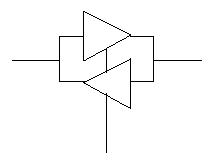
With tri-state logic circuits, this is no longer true. As their names indicate, they manipulate signals that can be in one of three states, as opposed to only 0 or 1. While this may sound confusing at first, the idea is relatively simple.
Consider a fairly common case in which there are a number of source circuits S1, S2, etc in different parts of a chip (i.e., they are not real close together). At different times, exactly one of these circuit will generate some binary value that is to be distributed to some set of destination circuits D1, D2, etc also in different parts of the chip. At any point in time, exactly one source circuit can generate a value, and the value is always to be distributed to all the destination circuits. Obviously, we have to have some signals that select which source circuit is to generate information. Assume for the moment that we have singals s1, s2, etc for exactly that purpose. One solution to this problem is indicated in this figure:

As you can see, this solution requires that all outputs are routed to a central place. Often such solutions are impractical or costly. Since only one of the sources is "active" at one point, we ought to be able to use a solution like this:

However, connecting two or more outputs together is likely to destroy the circuits. The solution to our problem is to use tri-state logic.

which is pretty close to the truth. The switch is just another transistor that can be added at a very small cost.
Any circuit can exist in a tri-state version. However, as a special case, we can convert any ordinary circuit to a tri-state circuit, by using a special tri-state combinatorial circuit that simply copies its inputs to the outputs, but that also has an enable input. We call such a circuit a bus driver for reasons that will become evident when we discuss buses. A bus driver with one input is drawn like this:

Here is a version for bidirectional signals:
